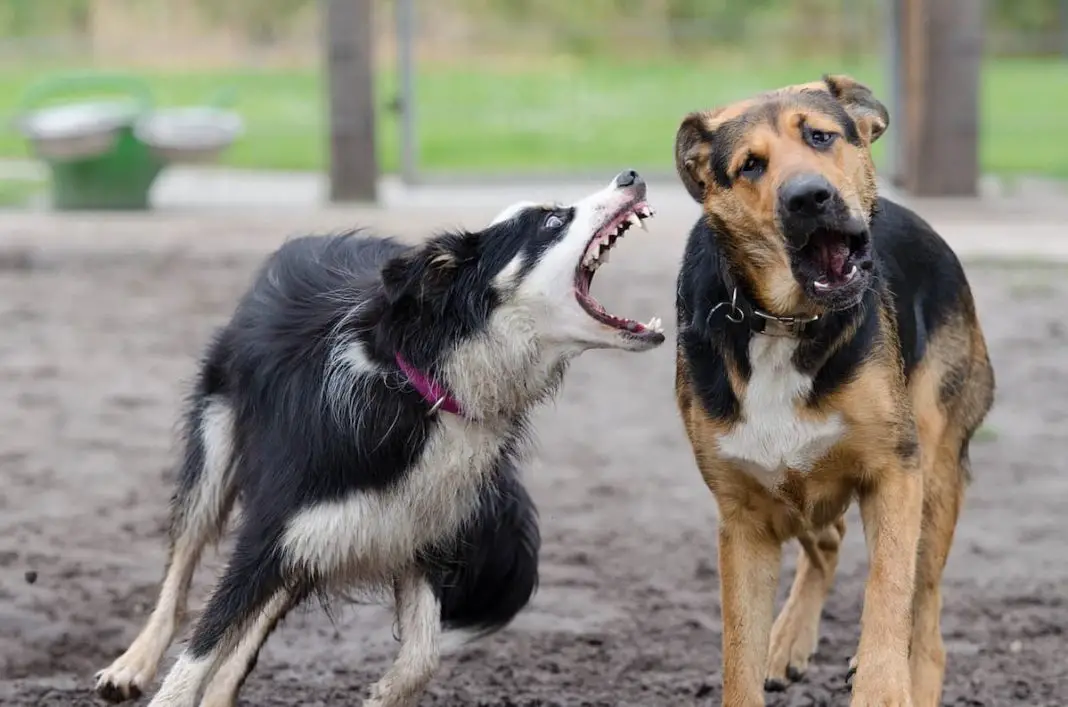Quicklinks:
- Understanding Border Collie Aggression Towards Other Dogs
- Identifying The Signs of Collie Aggression
- Understanding The Types of Aggression
- Preventing Your Border Collies Aggression
Border Collie Aggression Towards Other Dogs
It’s a beautiful day at the park, and your border collie is happily tinkering about, chasing their favourite ball or sniffing the bushes. All is calm until another dog appears. They start to approach your collie and all of a sudden; the calm is gone. Your border collie starts barking, snapping and growling at the new intruder, or maybe it’s the other way around and your collie is receiving the aggression from someone else’s dog.
It could be all over in a matter of seconds, or it may escalate into a full fight. In the worst-case scenario, one or both dogs could be seriously hurt, along with the owners getting bitten while trying to intervene.
Regardless of the outcome, a peaceful day suddenly turns into a stressful one and can leave you lacking the confidence to take your border collie to the park again.
Unfortunately, cases of dog to dog aggression appears to be on the rise. It’s easy for many people to wonder if it’s safe to walk their dog outside of their own homes.
Understanding the triggers behind aggression and why your border collie seems to ‘hate’ other dogs is important to resolving the problem. While not all aggression by your dog can be prevented, training can solve a lot of issues, which will help you to have a more enjoyable time with your collie.
Understanding Border Collie Aggression Towards Other Dogs
In its simplest form, your collie’s aggression could be defined as a negative reaction to another dog that causes the other dog to feel fearful or threatened.
However, your collie’s aggression is far more complicated than that and some actions that people perceive as aggression can even be playful or appropriate canine interaction.
For example, an older border collie may snap at a young puppy that’s pushing its boundaries and cause the puppy to cry. This is the older dog telling the puppy to behave and as long as it’s not excessive or results in injury to the puppy, it is a completely normal part of canine behaviour.
Growling and lip-lifting are other canine behaviours that we would term aggressive but are used by our dogs to voice their displeasure at the behaviour of another dog. These early warning signs are designed to stop unwanted behaviour by your border collie of the other dog and a well-mannered individual will respect them and back off.
Border collies are entitled to tell another dog their behaviour isn’t appropriate in this fashion – it’s correct canine communication, and the same as us telling someone we don’t like what they’re doing when they’re near us. Problems can arise when we decide to punish our dogs for voicing their feelings, or when a dog ignores the warning signs, it is being shown.
The other side of this scenario could be the other person who perhaps doesn’t realise that the behaviour their dog is displaying is aggressive and instead believes it to be ‘playful’ or ‘friendly’. This can result in the dog owner allowing their dog to bully other dogs, leading to a potential dog fight.
Identifying The Signs of Collie Aggression
There are many signs of aggression. A lot of these signs can be very subtle, using body signals that only another dog can recognise. We as humans can miss these subtle signs. If noticed, these early signs can help to predict the start of a dogfight. These signals include:
- standing stiff-legged
- staring at another dog
- lifting the tail over the back
- head back and raised
- baring the teeth
- growling
- circling another dog
- attempting to ‘tower’ over another dog by making themselves taller
- forcing another dog into a corner
- pinning a dog (often confused for play)
Understanding The Types of Aggression
Aggression can sometimes be fitted into boxes to represent the ‘type’ of aggression. While this is convenient when discussing aggression, it has to be remembered that this is a complicated behavioural issue and there could be many layers to the underlying problem.
Fear Aggression – Probably the most common cause for certain behaviours and a trigger behind other more specific types of aggression. Fear can cause your border collie to react violently towards another dog in an effort to prevent that dog from coming too close to them.
Resource Guarding – This is when your border collie feels the need to protect something they perceive as belonging to them. This could be anything from a toy, food, to their bed, or even a person. Resource guarding is complex and could only be triggered in certain situations or by certain dogs. This behaviour could also be linked to fear aggression, as your border collie could be afraid of something they value that could be removed from them.
Breed Aggression – This is when your border collie has an aggressive tendency towards a specific breed but is fine with most other breeds. This can often happen when your dog has been frightened or even attacked by a particular breed in the past, and has learned that that specific dog breed represents a continued threat to them.
Protective Instincts – Your border collie could become protective over either a person or another dog. This isn’t the same as resource guarding, as your dog isn’t fearful of the other dog or person is going to be removed, but maybe believes that they’re threatened by other dogs and so begins to protect them.
Overreaction to Bad Manners – This is sometimes known as ‘being the fun police. This happens when a dog overreacts to another who is being too exuberant or playful. This isn’t the same as a dog who growls or snaps to tell another dog ‘enough’. This is when your collie reacts to exuberance by attacking another dog. Some dogs can develop this behaviour if they constantly meet over-friendly dogs that don’t respond to their earlier subtle warnings.
Bullying – While bullying is used by us humans and not precisely suitable for dogs, there are instances when a dog will try to throw its weight around with other dogs and this can become more aggressive over time. This may be due to the dog being allowed to rough house with others or wanting to resource guard.
Pain-based Aggression – This is a type of aggression that can be often overlooked. Dogs are very stoic and tend to mask pain well until they are approached by a bouncing dog and fear that they’re going to be knocked over or jumped upon in a way that might hurt them. An example is when an older dog with sore joints, who lunges at another dog, fears that they may knock into them.
Sexual Aggression – This can occur in both males and females. Intact males could potentially fight another dog if they have caught the scent of a female in season. They could be fighting for the right to mate with her. Females may become aggressive when in season towards males because they’re not ready yet to mate. Hormonal changes as your border collie matures could also lead to aggression towards other dogs they previously tolerated.
Household Stress – Stress within a household affects your border collies, too. It can cause them to react aggressively and unexpectedly to other dogs. Noticeable times for this are during the holidays when a dog’s routine is disrupted and guests may be visiting.
Trauma – Occasionally, dogs who have suffered from extreme trauma may be prone to aggression. This is usually seen in abusive cases, such as where a dog has been used for fighting.
Reaction to Illness – Some dogs struggle to deal with illness in other dogs and could attack the sick dog out of fear. The illness within the dog makes the other dog anxious or causes the sick dog’s behaviour or smell to change, which could trigger an attack.
Neurological – While the majority of collies exhibiting aggression will have a trigger that can be determined, a minority of dogs will exhibit continued unpredictable aggression. This is usually linked to a problem in their brain (brain tumour, epilepsy), which causes sudden outbursts of aggression. This is also known as rage syndrome. It’s very rare and dogs will normally exhibit additional signs of a problem.
Preventing Your Border Collies Aggression
Step 1
Learn to recognize your border collies bodily signs of agitation. They could stare directly at another dog with the fur on the back of their neck standing. Their ears may flatten backwards, tilting their head slightly but never taking their eyes off the other dog. If intervention doesn’t occur, your collie may begin to growl or start attacking the other dog.
Step 2
Always put safety first if you own an aggressive collie. To prevent an injury to another dog, muzzle your border collie. Only after they learn to react without using aggression should you remove the muzzle while walking them or taking them to the dog park. You can still train your dog while their muzzle is still on.
Step 3
Socialize your border collie from a young age and as much as possible, but keep them on a short leash. The more your collie encounters other dogs, the less likely they are to feel immediate aggression when spotting one. Keep your collie on your left side, with their head level with your hip, winding any excess leash around your wrist. If your collie lunges towards another dog, issue a firm command of “No” and pull back and downward on the leash. Avoid pulling back and upward, as it will put your collie in a more aggressive “chest up” stance.
Step 4
Instruct your dog to sit down beside the sidewalk if another person and their dog are approaching from the opposite direction. Stand directly in front of your dog while the other dog passes, blocking your dog’s view, and speak calmly to them to keep their attention. When the other dog is at a safe distance away, give your dog a treat, praising them for sitting still. When your dog masters this task, allow them to continue walking. Always keep yourself between your dog and the other dog.
Step 5
Control your own reaction to your collie’s aggressive behavior. Issue commands firmly, but don’t yell. A dog can easily sense anxiety from their owner and your nervousness may heighten the tension.
Step 6
Consider getting your dog a gentle leader. These specially designed head halters will pull the dog’s head downward when the leash is pulled. As soon as your border collie exhibits the slightest aggression, pull gently but firmly on their leash and the gentle leader will make them lower their head, breaking their eye contact with the other dog, potentially averting any fights.








